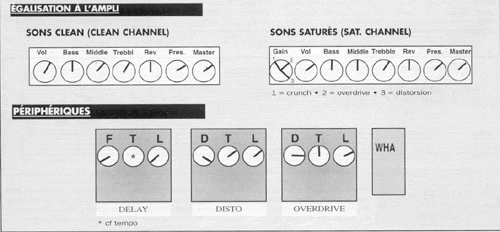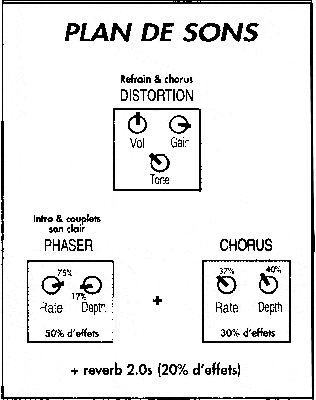Quelques techniques
de slide guitare et quelques plans de Ben
Apparue à Hawaï le siècle
dernier la technique slide consiste à jouer non plus en frettant les
cordes mais en déplaçant sur celles-ci un objet en métal permettant
de réaliser ces glissés si caractéristiques avant ou après les notes.
On a retrouvé cette technique
dans le blues avec l'utilisation du bottleneck.
Il est possible de jouer
en slide sur sa guitare habituelle mais quelques changements sont
nécessaires pour éviter des bruits "désagréables"...
Tout d'abord il faut
monter le tirant de vos cordes (light au minimum), ensuite il faut
augmenter l'action des cordes en montant les pontets du chevalet (pour
une électrique) ou en utilisant un réhausseur qui se place entre les
cordes et le sillet (acoustique).
Enfin il vous faudra
choisir un bottleneck ou une slide bar (si vous voulez imiter ben
parfaitement...)
Les bottlenecks sont
:
 |
en
acier, sonore mais bruits parasites.
|
 |
en
cuivre, moins de sustain mais un son plus chaud.
|
 |
en
verre, pour un son plus mat et des plans rapides (style solo de
Burn to Shine). |
Il y a également des
différences d'épaisseur et de longueur. Sachez par exemple qu'on utilise
les courts pour un jeu mixte frettes-slide.
Pour la position du bottleneck
vous avez le choix (conseil perso : prenez le doigt avec lequel vous
vous sentez le plus à l'aise); soit l'auriculaire pour un jeu mixte,
soit l'annulaire.
Le jeu en slide nécessite
généralement un accordage différent de l'accordage standard, les accordages
les plus usités par ben sont les suivants : 
A droite de chaque accordage
cliquez sur l'icône pour télécharger l'exemple
en mp3.
Les guitares : Commençons
avec les acoustiques. L'instrument de prédilection de Ben est
bien sûr la Weissenborn. Il en posséde plusieurs mais
la principale date des années 1910 (une des premières).
Pour les guitares traditionnelles; sa préférée
est une Gibson LG 2 des années 40 (équipée d'un
micro Sunrise). Il a également une Martin OO18 et une National
Tricone.
Pour les guitares électriques
on distingue d'abord les Weissenborn amplifiées. La index date
des années 30 et est équipée d'un micro Sunrise.
Il possède aussi des modéles customs plus récents,
comme la Ashes construite par un luthier californien avec des micros
Bill Lawrence. Adepte de la lap-slide guitare, Ben en a plusieurs,
de toutes les époques. Enfin ses indexs guitares électriques
sont des Fender Stratocaster, Telecaster et une Gibson ES 335.
Les amplis :
Ben Harper joue sur un Groove Tube Solo (+baffle Marshall), un Fender
Twin 58, un Demeter ou encore un préampli Soldano.
Les effets : On
notera un Tube screamer Ibanez, une Ibanez delay pedal, une wha-wha
Vox, un flanger Electro Harmonix, une pédale de volume ou plus
récemment un pédalier avec disto et chorus. Ben aime
parfois utiliser des plans hendrixiens sur ses parties de Weissenborn,
comme les bandes passées à l'envers.
Les plans de sons :


Les micros, une interview
(en anglais pour le moment) de Ben Harper concernant les micros
Seymour Duncan, qu'il utlilise :
Groundwire: How
were you introduced to Duncan pickups?
Ben Harper :
I never stop trying to better my
tone. When you’re in constant pursuit of a tone that is perfect
for you, you end up going through a lot of different guitar makers
and pickup manufacturers. The way I came across Duncan was through
a friend, Keith Nelson from Buckcherry. He met a guitar builder
from New Jersey named Rob Mondell of Justin Sain Guitars who had
made him some guitars. Keith called me up when he got his first
one and he was floored. He said, “Man, you need to get in touch
with this guy!” But it just never happened. Then one day, Keith
shows up at my house with two custom lap steels guitars that Rob
had made for me. In the past, Rob only made standard roundneck guitars
and these were his first lap steels. Rob’s main guitar designs
are made with metal and wood in the tradition of the Zemaitis guitars,
but they’re very much his own. At the time I hooked up with
Keith, I was right in the midst of a tour and was going to be away
for the next eight months. Because the guitars didn’t have
flight cases and I hadn’t heard them yet, I left them at home.
I wasn’t going to take out something that hadn’t been
sound tested, and I already thought that I had the best-sounding
lap steel.
After the tour ended,
I went into the studio to record Diamonds On The Inside, which is
coming out in March. When I go into the studio, I bring every single
guitar I have because you never know what tones are going to fit
each of the songs best. There’s a song on it called “Temporary
Remedy” that’s bass, drum, guitar—three-piece in
the true Cream/Hendrix tradition. I was plugging in all of my 20
main lap steels, trying to find the right sound, but it just wasn’t
happening yet. Then I plugged in one of Rob’s guitars and it
just blew up. Everyone in the control room started jumping up and
down in that sheer instinctual way that only good tone and good
music can bring out, and they were just freaking. That’s the
guitar! It was a new sonic step forward.
The pickups in Rob’s
guitars are Duncan ’59s that are wired for standard humbucker
and split coils. For me, what’s amazing about these pickups
is that you can split them to single-coil. Splitting the neck pickup
is key because you get into very reverberant rooms where low end
takes off and neck pickups naturally have a lot of low end resonance.
The ability to split them to single-coil cuts down the low resonant
frequency without you having to go to your bridge pickup. It allows
you to still use both and get a rich sound without clashing with
the bass. So it’s like having four or five guitars in one,
being able to split each pickup in different patterns. These pickups
are really kickin’ for all my electric stuff. They’re
just putting out like none other. The better the guitar sounds,
the better you’re going to be playing it, period.
What I love the most
about the ’59s is how they’ve transformed my electric
lap steel. As humbuckers, they give it a true Les Paul sound and
when I split the coils to single-coil, they give me what I consider
to be more of a true Strat tone. It’s not sort of like a Paul
or sort of like a Strat, it’s nailing them. There’s no
compromise. It’s finally brought me to the tone that I’ve
heard in my head, as far as my electric slide playing goes and I
can control them like no others.
GW: Where do you
find that single-coil and humbucking sounds work best?
Ben Harper :
A single-coil sound is sweeter. If
there’s a verse that I want to be sweet, then most likely,
I’ll pull the neck pickup up in single-coil. It gives a gentleness
that works really well to complement my vocals. Then for a chorus,
when I really want to crush or go into overdrive, I can just drop
it down into double-coil and it’s just perfect for choruses
and solos. So it’s a complement to my verse/chorus style of
singing. A single-coil just has got a delicate nature that adds
to a ballad, to the softer side of a song. In my music, it’s
super important because the dynamics are jumping within the song,
as well as from song to song. So I’ve got to be able to have
different tones.
GW: You recently
tested the Mag Mic on one of your acoustics. How did it rate?
Ben Harper :
The Mag Mic is great. It’s got
a very balanced frequency response from the low wound strings to
the plain steel strings. The mic feature is highly functional and
it’s positioned in the best place — right up out of the
soundhole where there’s the most air movement and it’s
in proximity to your fingers. It has a blend for natural acoustic
resonance, as well as magnetic pickup. You can blend in more or
less mic, which is great for playing live and in the studio because
you can dial the sound in depending on how reverberant a room is.
It’s very responsive and it’s a very workable microphone
sound. You don’t want a mic that’s going to pick up a
lot of the slap back from the room and just cause phasing problems.
You’ll be getting more of the room sound than the true sound
of the guitar itself, which is what you don’t want. What’s
great about where this mic is placed on the pickup is that it’s
shielded from anything other than the acoustic sound of the guitar.
Having a 12-string option also ups the value, as do the adjustable
pole pieces. Having as many options to get the sound that you want
to get, whether it’s the blending of the mic or the adjustment
of the pole position, it’s ideal, really. It’s well put
together and I’m a fan.
GW: Describe your
backline rig.
Ben Harper :
I have a couple of different amps.
I use a Demeter 100 watt head and what’s great about it is
that it’s got very true clean and dirty channels. The dirty
channel gets up and kicks ass, and the clean channel is very sweet
like a tweed Fender Bassman, which I love. And I also use a ’50s
tweed Bassman for some of the clean tones. I plug all of my guitars
through that rig, but I can also A/B them to go between the amps.
So I can use the dirty or clean channel from the Demeter and I can
run a dirty or clean channel through the Bassman. For effects, I
have an old Ibanez TS808 Tube Screamer, a Vox wah, an old Ibanez
Analog Delay, and an Electro-Harmonix Small Stone Phaser.
GW: Tell us about
the new record and your plans for the coming year.
Ben Harper :
The songs range in sound and style
from ballads to straight-up rock and reggae style music, blues,
soul, and funk. It’s just got the mix of music that I love
and feel. The record comes out on March 11th and then I’ll
be touring. I usually tour in two-year cycles, so I’ll be out
from this March on. The tour will take us through America, Canada,
Australia, England, Japan, Europe, Brazil, and South Africa. That’ll
keep us busy until the next recording session! punches, you will
naturally become the best.

